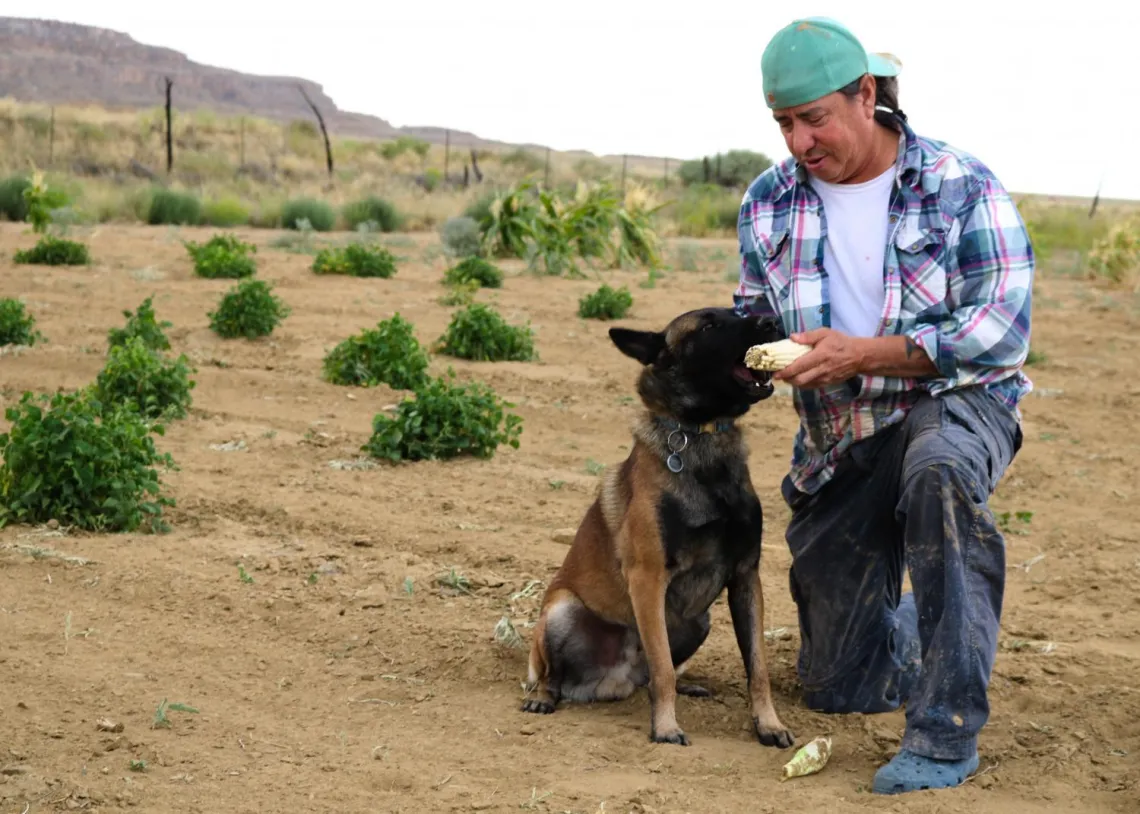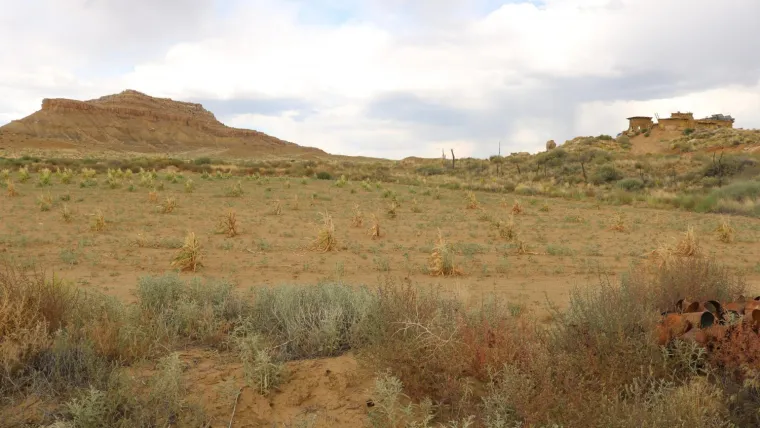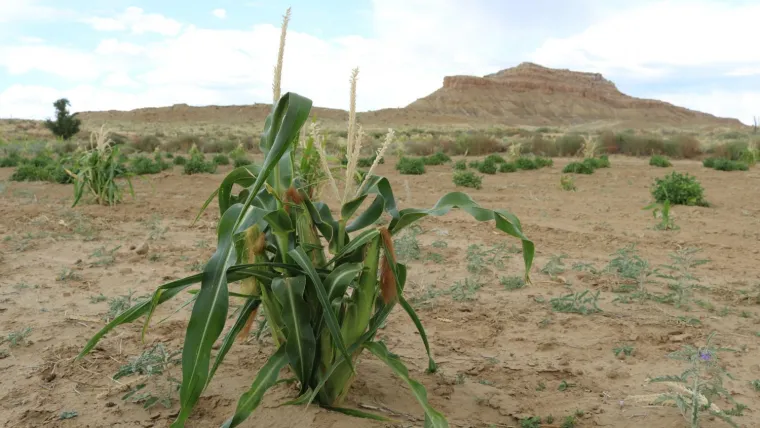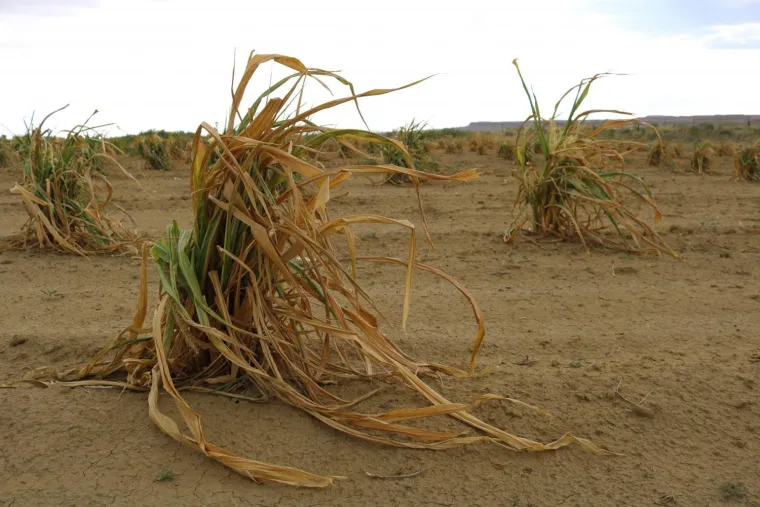This Hopi dry farmer is trying to safeguard seeds from threats of climate change, commercialization

Michael Kotutwa Johnson shucks an abnormally large ear of Hopi corn, hurling it toward his dog, Soya, to play fetch with his self-proclaimed “corn-dog.” It’s a Belgian Malinois, with a Hopi name, which translates to "Planting Stick."
“So, this is non-irrigated Hopi white corn, and we have over 17 different varieties. All of these crops are specialized,” said Johnson, “drought-resistant to our environment and nutrient dense because they’re not irrigated.”
It’s a cloudy September day in Second Mesa at one of his cornfields during the monsoon season.
“Now, you can hear the wind coming in and the thunder. That’s a monsoon cloudburst coming in here at some point,” said Johnson. “Our main factor out here to raise things in the desert, of course, is how much snowfall we get a year.”
Hopis mainly live in 12 ancient villages atop First, Second and Third Mesa, where the 1.5 million acre reservation typically receives between about 6 and 10 inches of average precipitation, both rain and snowfall annually.
“Snow snakes down into the ground, sits in there rather than the runoff that you’d have from a monsoon rain,” Johnson explained. “And the way it’s layered underneath the surface here, you’re able to grow just about anything you want, non-irrigated wise.”
In spite of such little precipitation, these resilient villages have endured the test of harsh weather and time. Located atop Third Mesa, Old Oraibi is considered to be the oldest continuously inhabited village in the U.S. since about 1150.
Hopis have lived and farmed this way on these same lands for generations amid these incredibly tough conditions. They’re still successful “because we’ve been out here for 3,000 years, there’s a lot of ingenuity that we have,” Johnson elaborated, “and so, we’ve adapted our plants to fit this environment. We don’t manipulate the environment to fit our plants.”
But climate change is harming agriculture. It’s an undeniable challenge that even some of the most resilient Hopi dry farmers are now facing in northern Arizona.
He’s now trying to find solutions to combat these environmental trends through research at the University of Arizona, as an assistance specialist within the School of Natural Resources and the Environment.

Michael Kotutwa Johnson oversees 11 acres of fields between Second and Third Mesa on the Hopi Reservation.
Since last September, Johnson, a 253rd generation dry farmer, has attended the COP28 U.N. Climate Change Conference in December in Dubai at the United Arab Emirates, on behalf of the University of Arizona’s Indigenous Resilience Center.
Now, he’s in charge of an ambitious, nearly half-million-dollar four-pronged project, funded by the Rockefeller Foundation’s Climate Exploration Fund, with an emphasis on Indigenous communities.
More than $1.3 million has been funneled to three Indigenous-led food-related projects worldwide, but Johnson’s research is the only one based not just in the Southwest, but all across Indian Country.
“They’re the ones who really face the most, when it comes to climate fluctuations, health inequities and historical exclusion,” said Alexandra Payne, food initiative program officer at Rockefeller Foundation. “And at the same time, they are the holders of some of that very deep, if not the deepest knowledge in how to kind of combat these issues.”
Although agriculture is a major source of global greenhouse gas emissions, climate change has weakened food systems worldwide. This is especially the case for traditional farmers from more vulnerable communities, like the Hopis.
“This opportunity we had was to work with Michael to take these seeds that his tribe and himself have been stewarding for eons,” added Payne. “Being able to grow provides this continued climate resilience to maintain nutrient density, and seeds in a seed vault don’t do that. You need people and practices that are attached to those seeds, year over year.”
Johnson has already begun planting this month in Tucson at the first of three spots chosen for this study. In April, he’ll go to Arcosanti, south of Prescott, and then return to his home at Second Mesa in May.
He’s looking to identify the best ways to grow Hopi dry corn, developing a data governance model to safeguard this traditional agricultural knowledge, cultivating a Southwest regional food network, and even conducting nutritional analyses on at least two varieties.
“Looking at the nutritional components, that’s often overlooked,” said Trent Teegerstrom, associate director for tribal extension program at the University of Arizona’s Cooperative Extension. “It’s been done, but not done enough, because it’s not cheap either.”
He hopes these methods can one day help not only Hopis, but tribal producers statewide.
“They’re all taking different avenues to it,” added Teegerstrom, “but it comes back to, from an extension standpoint, getting the information back out in a relevant manner.”
But tribes have long worried about how that often proprietary information is shared in an ethical way.
“Well, therein lies my role,” said Stephanie Russo Carroll, associate research professor at the University of Arizona’s Udall Center for Studies in Public Policy, “which is to work with Mike and others on the project to begin to institute policies and practices that align with Indigenous data sovereignty, especially around seeds.”
She’s from the Native Village of Kluti-Kaah in Alaska and also director of the university’s Collaboratory for Indigenous Data Governance.
To her, this idea of Indigenous data sovereignty “really reaffirms the rights of Indigenous peoples, as collectives to govern the collection, ownership and application of their data.”
Basically anything that can be digitized, as a way to assert sovereignty.
“When we think of this in terms of agriculture, it is informed and really motivated by the roles and responsibilities that Indigenous peoples have within their communities,” added Carroll, “for information, knowledge, data, and our relations such as seeds and plants.”
In this case, seeds are considered to be cultural artifacts, but plenty of challenges persist.

Ears of corn are grown in bundles by Hopi dry farmers and later thinned over time.
Commercialization is one of them. In the past, Johnson has routinely turned away seed sellers from overseas that have sought to exploit them.
“We’re always with commercialization,” said Carroll, “always concerned about people taking things out of context, which I think is really a fundamental issue around agriculture, and anything related to the climate.”
Carroll shared that “there is a real strong need for really high level types of standards and expectations” outlined through tribally-informed data agreements with the federal government, nonprofits, corporations and even philanthropic and charitable organizations, including the Rockefeller Foundation.
“For Mike, when he’s doing his work with Hopi, and also really, potentially trying to transform Rockefeller Foundation’s own conceptions of how they do agreements, and what they need to keep confidential and private and what they can share,” said Carroll. “Everybody thinks it’s somebody else’s responsibility, when, in fact, all of us need to be doing this work.”
Safeguarding that data from those special seeds is a top priority since they’re in such demand and short supply among Hopi dry farmers today.
“With late freezes, with very higher temperatures, longer periods between rain and snowfall, all of that has really shifted the seasons,” said Hopi Federally-Recognized Tribes Extension Program agent Susan Sekaquaptewa, “what we knew to be the seasons in this area. That does impact the harvest in the end, whether your crops actually germinate and come up or freeze.”
Such conditions are affecting crop yields, causing an accelerated dwindling of corn storages.
“In the last two years, it was very, very, very scary,” added Sekaquaptewa, “because they had been using up the past two, three, four years’ worth of corn storage. But not bringing anything in to replace it.”
And it’s even hurting their spirituality since Hopis consider corn sacred.
“There are families who don’t have much, and we’re seeing a shift in our cultural practices of seeking that elsewhere when you can’t grow it yourself,” said Sekaquaptewa. “And that’s really stressing the community, and how we move forward.”
All the more reason why Johnson’s research is so essential, not only to stay sustainable, but also to protect their Hopi way of life.
“This year, it was a beautiful, beautiful spring, we had lots of snow, the ground was moist when we planted. We all had wonderful hopes,” said Sekaquaptewa. “My field, they germinated, came up and then they never never got beyond that, because I didn’t get a lot of rain. Not enough. I didn’t bring anything home this year.”
While some dry farmers fared better than others, not all of Johnson’s latest harvest didn’t survive this summer’s extreme heat stress among rows of corn.

Rows of heat-stressed corn husks are withered and bleached by the sun in September 2023.
“It was too hot for too long, so we had I think probably almost two weeks of 100-plus temperatures, and it fried a lot of them,” said Johnson. “We won’t have any rains all the way from March until probably the last week of July.”
Husks are withered and bleached by the sun.
“By touching each one of these plants like that, they know you care about them,” added Johnson. “It’s kinda fun when I go through with my little tractor and hit them, and as I go, I put my hand out, like little high-fives.”
And that saddened him, but Johnson hasn’t shied away from planting his seeds this season. His crops, part of this next harvest, will be gifted to the village of Old Oraibi, where Johnson hails from.
“So, a lot of my job, that’s my responsibility is to raise more of these types of seeds,” said Johnson, “so that the younger generation can get incentivized to plant. But as a society, we don’t plant enough.”
Despite that and the dire climate situation, he’s still optimistic “not gross domestic product, not big nation-states, but small, little pockets of Indigenous people are going to save the globe. I really believe that.”
